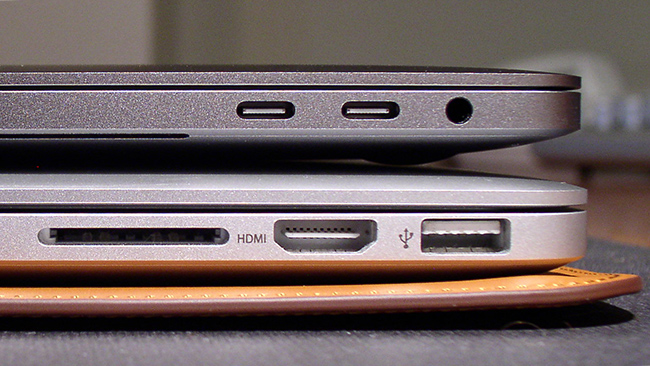
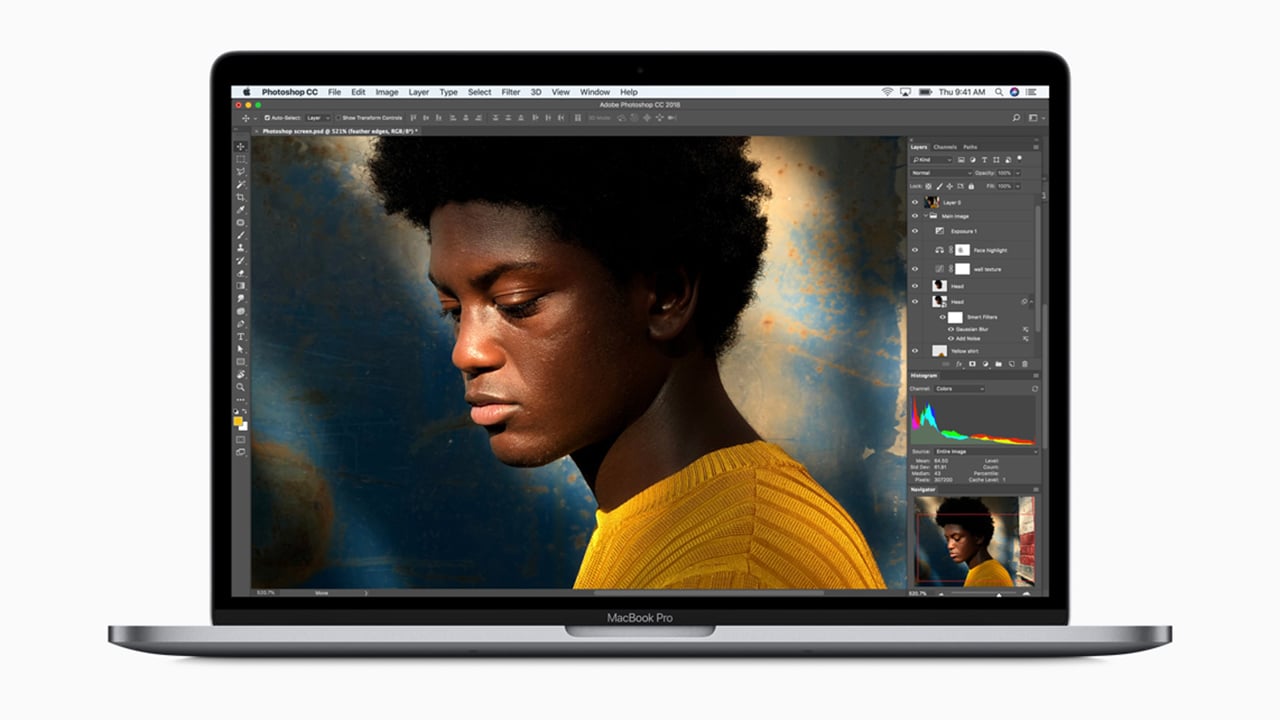
Review: Read on as we take a good look at Apple's latest 15" MacBook Pro.
July was a good month for Apple power users, with the simultaneous release of Blackmagic Design’s eGPU and a refresh of Apple’s popular MacBook Pro line. Although these new laptops retained the previous model’s form factor, they gained a bump-up in processors, RAM, and storage capacity.
Apple loaned me one of the Touch Bar space gray 15” models to review. It came maxed out with the 8th generation 2.9 GHz 6-core Intel Core i9 CPU, 32GB DDR4 (faster) RAM, Radeon Pro 560X GPU, and a 2TB SSD. The price range on this model is pretty wide, due in part to the SSD options. Touch Bar 15” configurations start at $2,399 USD and can go all the way up to $6,699 USD, once you spec the top choice for everything. My configuration was only $4,699 with the 2TB SSD. Of course, that’s before you add Apple Care and any accessories, like the sweet new premium leather sleeve ($199 USD).
Before you point me to the nearest Windows gaming machine instead, let me mention that this is the fastest and best laptop Apple has made. Apple engineering has nicely balanced power, size, weight, and battery life in a way that’s hard to counter. It is pricey, but my MacBook Pro experience, like that of others, has been one of good value. MacBook Pros generally last years and if you use them for actual billable work (editing, DIT, sound design, etc), then the investment will pay for itself.
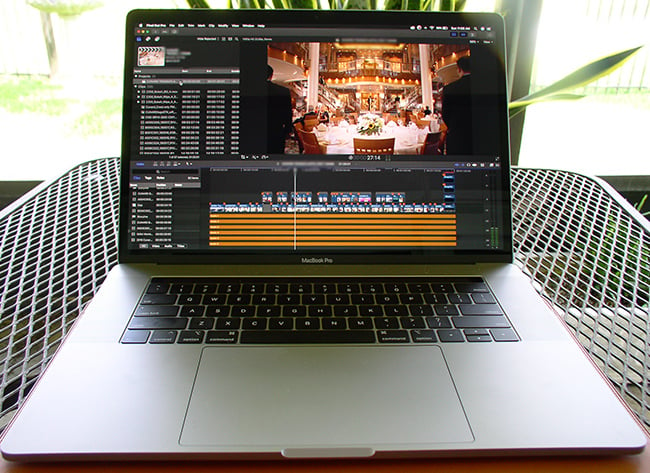
What did Apple bring new to the mix?
When Apple introduced the Touch Bar in 2016, I thought ‘meh’. But after these couple of weeks, I’ve really enjoyed it, especially when an application, like Final Cut Pro X extends its controls to the Touch Bar. These units also include the T2 chip, which powers the fingerprint Touch ID and the newly added “Hey Siri” commands. The Retina screens on these laptops are gorgeous with up to 500 nits brightness and a wide color gamut. True Tone was added, which adjusts the display’s color temperature for ambient lighting. Generally, it warms up the screen when under interior lighting, which reduces eye fatigue if you are working with a lot of white documents. But my recommendation is that editors, colorists, photographers, and designers turn this feature off. Otherwise, the color balance of media will appear too warm (yellowish).
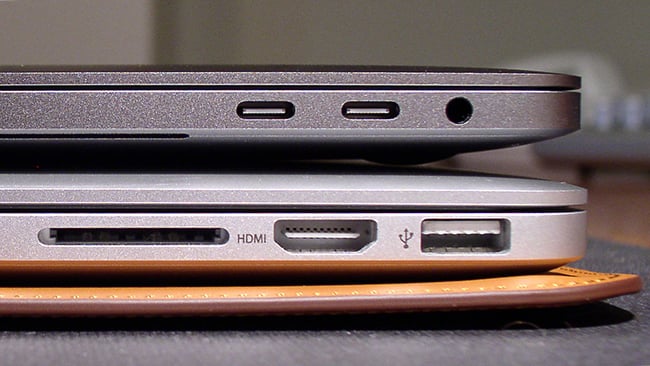
The 2014 MacBook Pro (bottom) compared with the 2018 model (top)
The 2018 15” MacBook Pro has four Thunderbolt 3/USB-C ports (two internal 40Gb/s Thunderbolt 3 buses) and a headphone jack. Gone are all other connections, so plan on purchasing an assortment of adapters to connect peripherals, such as those ubiquitous thumb drives. Thunderbolt 3 supports power, so no separate MagSafe port is required. (Power supply and cable are included.) When connected to a Thunderbolt 3 device with an adequate power supply (e.g. LG displays sold on Apple’s site or the Blackmagic eGPU), then a single cable can transfer data and power the laptop. One caveat is that Thunderbolt 3 doesn’t pass a video signal in the same way as Thunderbolt 2. You cannot simply add a Thunderbolt 3-to-Thunderbolt 2 adapter and connect a typical monitor’s MiniDisplayPort plug. External monitors without the correct connection will need to go through a dock or monitor adapter. (This is also true for the iMac Pros.)
Is it time to upgrade?
I own a mid-2014 15” MacBook Pro (the last series with an NVIDIA GPU), which I purchased in early 2015. Three years is often a good interval for most professional users to plan on a computer refresh, so I decided to compare the two. To start with, the new machine boots faster and apps open faster. It’s even slightly smaller and thinner than the mid-2014 model. Both have fast SSDs, but the 2018 model is significantly faster (2645 MB/s write, 2722 MB/s read). Both machines handled 4K ProRes footage just fine at full resolution using various NLEs. Exports to ProRes and H.264 were approximately twice as fast from Final Cut Pro X on the newer MacBook Pro. The same exports from Premiere Pro were longer than from FCPX, but faster on the 2018 machine, as well.
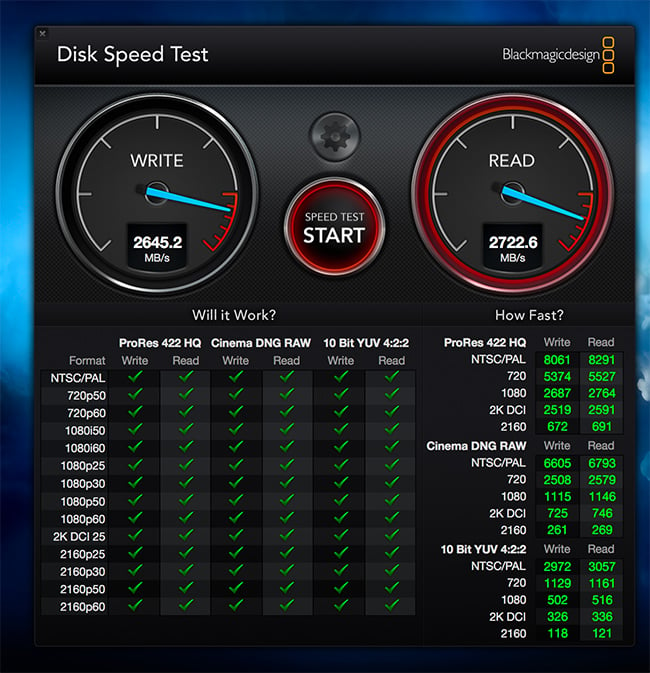
2018 MacBook Pro internal disk speed test
I also had one day of overlap between the loans of the MacBook Pro and the Blackmagic eGPU (featured in a previous review). As with the 13” MacBook Pro, DaVinci Resolve’s real-time playback performance and exports were improved by about a 2X factor with the eGPU connected. Naturally, the 15” machine by itself was quite a bit faster than the 13” MacBook Pro. Even with this powerhouse MacBook Pro, the Blackmagic eGPU still adds value as a general appliance, as well as providing Resolve acceleration.
One last note on battery life. The spec claims about 10 hours, but that’s largely for simple use, like watching web movies or listening to iTunes. Most of these activities do not cause the graphics to switch over from the Intel to the Radeon Pro GPU, which consumes more power. In my editing tests with the Radeon GPU constantly on - and most of the energy saving settings disabled - I got five to six hours of battery life. I ran a “heavy load” test, which involved looping my sample 1080 timeline (with 4K source media) full screen at “best quality” in FCPX. This is obviously a worst case, but the charge only lasted about two hours. In short, the battery capacity is very good for a laptop. However, if you plan on a heavy workload for an extended period of time, stay plugged in.
The 2018 MacBook Pro is a solid update that creative professionals will certainly enjoy, both in the field and even as a desktop replacement. If you bought last year’s model, there’s little reason to refresh your computer yet. But three years or more? Get out the credit card!
Tags: Technology


Comments